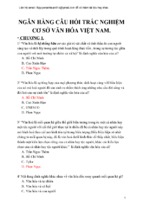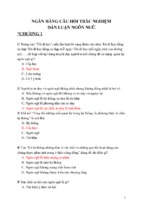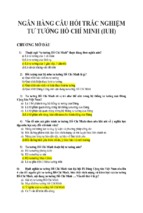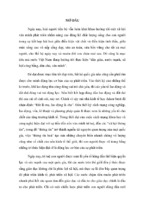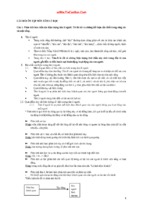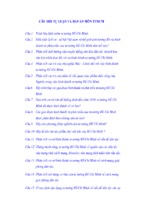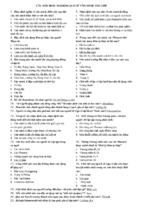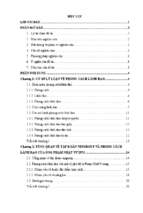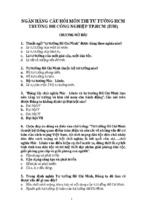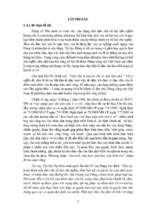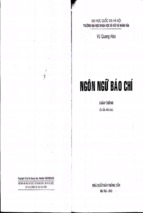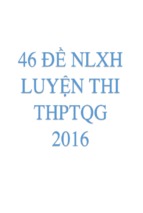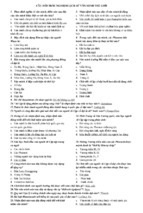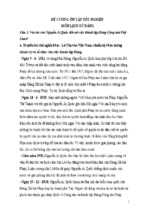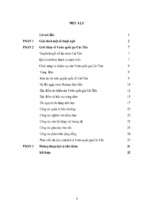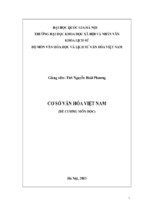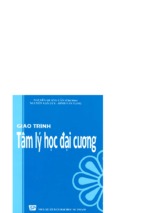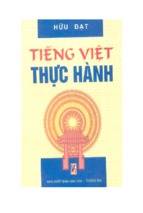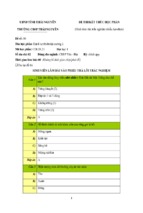MINISTRY OF EDUCATION AND TRAINING
MINISTRY OF AGRICULTURE AND RURAL DEVELOPMENT
VIETNAMESE ACADEMY OF FOREST SCIENCES
VU ĐINH THINH
Study on some technological parameters to fabricate particle boards made from
Acacia mangium Wild bark
Specialty: Forest product processing technology
Code
: 9549001
SUMMARY OF TECHNICAL PROGRESSION THESIS
Hanoi, 2020
The work was completed at the Vietnamese Academy of Forest Sciences
Supervisor:
1. Assoc. Prof. Dr. Vu Huy Dai
2. Assoc. Prof. Dr. Nguyen Thi Bich Ngoc
Chairman:
Reviewer 1:
Reviewer 2:
Reviewer 3:
The dissertation is defended in front of the Institute's thesis-judging council
Vietnamese Academy of Forest Sciences
At hours minute, day month year 20
The dissertation can be found at: National Library and Vietnamese Library
Academy of Forest Sciences
PUBLISHED SCIENTIFIC WORKS
RELATED TO THE THESIS
1. Ta Thi Phương Hoa, Vu Dinh Thinh, Vu Huy Dai, 2013.
“Determining the main chemical and physical properties of Acacia mangium
bark". Journal of Agricultural Science and Rural Development, 22: 117-120.
2. Vu Dinh Thinh, Vu Huy Dai, 2016. “The influence of bark rate on the
mechanical properties of A. acacia bark composite boards ”. Journal of
Forestry Science, 4: 4749-4753
PREFACE
1. Rationale and problem statement
Currently, the recovery rate of plantation timber in Vietnam is very low,
approximately 30% - 35%. In a tree, the bark proportion is about 10 - 15%,
branches: 25-30%, roots: 10-15%. Bark, roots, leaves are all left in forest, and not
being used for the production of fiberboard and particle board, and new types of
products. Study on the use of bark to produce composites is needed to improve the
efficiency of using wood materials and open up a new trend of efficient use of bark
in the wood processing industry. Acacia species have outstanding advantages in
growth rate and are suitable for many ecological regions in Vietnam. Acacia forest
area accounts for about 75% of the plantation forest area. The volume of bark is
relatively large. Therefore, detailed study is required to investigate the effect of
different parameters on the production of Acacia mangium bark-based composite.
2. Research objectives
2.1. Theoretical objectives:
(1) Determine the effect of different parameters (time, temperature) on the quality of
the composite without adhesives; (2) Determine the effect of bark and wood chips
ratio on the quality of the composite with adhesive.
2.2. Technical objectives: (1) Investigate parameters used for the production of the
bark - based composite; (2) Determine the ratio of bark and wood chips; (3) Proposing
suitable parameters for the production of the composite from A. mangium bark that
meet the standards of construction materials (soundproof and heatproof boards).
3. Material: Acacia mangium bark of 8 - 10 years old, selected from Hoa Binh.
4. Scope of research
Fixed elements: The raw materials were the bark of Acacia mangium 8 - 10 years old
and scraps of Acacia mangium peeling process in Hoa Binh; Adhesives: UF glue
(Urea-Formaldehyde), 10% glue. Using molds with dimensions (length x width x
thickness) of 400 x 400 x 16 mm; Expected a desity of composite board: γ = 0,750g /
cm3; Pressing pressure (P): 1.6 MPa.
Change factors: Change the pressing parameters (time, pressing temperature) to
make a bark composite with and without using adhesive:
+ 3 levels of pressing time (τ): τmin = 16 minutes, τo = 18 minutes, τmax = 20
minutes.
+ 3 levels of temperature (T): Tmin = 160oC, To = 180oC, Tmax = 200oC.
Output factors: Main mechanical properties of bark composite boards: density,
thickness swelling, water absorption, MOR and MOE and tensile strength
perpendicular to the board surface.
5. Scientific and practical significance
Scientific significance: The results of the thesis on the characteristics of the
microscopic structure, chemical composition, major physical properties of the bark
are the scientific basis for the effective use of bark in the wood processing industry.
The results of the thesis are also the scientific basis for the coming studies on
composite technology from bark and wood scraps.
1
Practical significance: Preliminary study on the production of Acacia mangium
bark-based has a great practical significance in effective use, improving the wood
recovery rate and protecting the environment. The results of the thesis are the
technical basis for the selection of technological parameters of making Acacia bark
composite boards used in construction and furniture as insulation, sound absorption
which should be environmentally friendly materials.
6. New contributions of the thesis
This is the first study to make composite boards from A. mangium bark in Vietnam.
The microstructure, physical properties, chemical composition of Acacia mangium
bark were determined and they were used for the production of the bark composite.
Determined the relationship and values of technological parameters of making
acacia bark composite boards to meet the quality requirements of construction
materials. Determined the relationship of the proportion of composite board
structure and the mixing ratio between bark chips and wood chips affecting the
quality of composite boards. Determination of sound absorption coefficient and
insulation capacity of acacia bark composite materials as a basis for the use of such
materials as sound absorption and heat insulating materials.
7. Dissertation layout
The thesis was written with 123 pages in total, including 45 pictures and 33
tables, the thesis was prepared as follows:
Introduction (5 pages).
Chapter 1: General introduction (18 pages).
Chapter 2. Theoretical basis(14 pages).
Chapter 3. Materials and methods (22 pages).
Chapter 4. Results and discussion (61 pages).
Conclusions, shortcomings and recommendations (3 pages).
Totally, 94 documents were cited within thesis. Among them, here were 45
Vietnamese documents and 49 foreign languages documents.
Chapter 1. LITERATURE REVIEW
1.1. General introduction of composite materials
1.1.1. Composite material: Composite material is a material combined of two or
more component materials in order to create a new type of material that is different
from the original materials as isolating.
1.1.2. Classification of composite materials: polymer composite (PC) materials is
classified in two ways based on the characteristics of two phases: the polymer
matrix phase: thermoset PC-based materials, thermoplastic PC-based materials; the
reinforcement phase: dispersed reinforcement (powder); Short fiber or flake
reinforcement; Continuous fiber reinforcement (carbon fiber, glass fiber ...); Airpadded or porous; Polymer mixture - polymers.
1.1.3. Composite boards made from bark: Composite bark is a type of artificial
board product, like particle board. Bark composite boards are made from bark chips
which may or may not use any artificial composite to be an adhesive.
1.2. Overview about research on using bark as composite material
1.2.1. Abroad study
Chow and Pickles (1971), Hengst and Dawson, Place and Maloney (1975),
Demirbas (2005) studied the coefficient of heat transfer, rate of heat, coefficient of
2
thermal expansion. Burrows (1960), Chow (1972, 1975), Wellons and Krahmer
(1973), Troughton (1997) concluded that pressed at temperature ≥ 1800oC and the
pressure can create bark boards without adhesive based on plasticizing the lighin
and the metabolism of extracts like a glue to create the bonds in bark boards [54],
[55], [84]. Roger Pedieu, Bernard Riedl, André Pichette (2008) investigated the
structure of birch bark board with outner layer (35, 40, 45) % with UF glue (UF
11%), inner layer (65, 60, 55) % with UF glue (7% UF), board size (560x460x12)
mm, density 0.75 (g/cm3), temperature 180oC, pressing pressure 180 KPa.
Research has shown that Particle boards have the structure ratio: bark chips / wood
chips / bark chips (20/60/20) % for the best mechanical properties [80]. Research
results of the US Forest Products Laboratory (1971) show that the chemical
composition of bark is different from wood in both coniferous and broadleaf trees.
In broadleaf bark, lignin makes up 40-50%, polysaccharides 32-45%, extracts 510%, inorganic up to 20%. Fengel and Wegener (1983) showed that compared to
wood, bark has higher swell and lower anisotropic, but the insulation and sound
insulation are higher. Gireesh Kumar Gupta (2009) studied that bark boards with an
expected thickness of 6.25mm and apparent density of 0.8 to 1g / cm3, pressing
temperature varying from 170oC to 300oC. The results showed that at a temperature
higher than 230oC, the surface of the plank is burnt because it reduced the bark's
chemical components, adversely affecting the properties of the board. Roger
Pedieu, Bernard Riedl, André Pichette (2008) studied the use of Birch bark for a 3layer particle board: the inner layer is wood chips, the two outer layers are bark
chips, the results show that the generated board achieves some good characteristics
like hydrophobic, soundproof and thermal insulation. Chow (1975) showed that the
phenolic substances in the bark of Douglas Fir and Red Fir can be polymerized at
high temperatures. Based on the study of heat softening, the heat softening of wood
and bark at temperatures below 1800oC the wood and bark will be plasticized. This
plasticizing effect is very important in setting the parameters. The reaction of bark
at a temperature greater than 180oC is a partial polymerization and degradation of
bark components. These thermodynamic reactions are important in the manufacture
of bark composite boards.
1.2.2. Domestic research
Tran Vinh Dieu et al. (2003) studied the creation of composite based on PP
reinforced with jute yarn. The material is made by layering PP-MAPP films and
jute yarn according to the design and then pressing on hydraulic presses (flat
presses in closed molds) under a pressure of 7MPa for 50 minutes.
Trieu Van Hai (2016) studied some factors affecting the technology of
creating composite materials from bark and polyethylene. The author studied
characteristics of Acacia mangium bark: average bark thickness of 1.1 cm; the rate
of bark accounts for 6.03% of the timber volume; diameter of fiber from bark: 19.7
µm to 21.1 µm; The fiber length varies from 1,056 µm to 1,107 µm and produced
the composite material from the bark of Mangrove Acacia and HDPE plastic
(WPC).
1.3. Conclude the overview of research issues
There are many researches over the world about bark composite boards with
or without adhesive. Various studies have confirmed the feasibility of using all or
part of the bark as a raw material for composite board production. Most bark
composite boards have low to moderate mechanical and physical properties and
this can be improved in further research. In Vietnam, studies using bark in general
3
and A. mangium bark in particular are not many, especially researches about
composite materials like some influencing factors of technology to create
composite materials from bark and polyethylene. Research to create bark composite
materials with good soundproofing and heat insulation used in carpentry and
construction.
Chapter 2. THEORETICAL BASIS
2.1. Bark
2.1.1. Introduction of bark: The bark protects the trunk, stores nutrients, bark
thickness will increase with age. The ratio of bark to trunk depends on the tree
species, age of trees and growth conditions. Normally, the amount of bark of the
trunk varies from 6 to 15% depending on species and growth conditions. The
proportion of bark is highest in the branches and tops, accounting for 20-35%.
2.1.2. Structure of bark: Bark is the outermost layer of the trunk. From the outside
into the shell is divided into 4 parts: the epidermis, the epidermis, the posterior ring
(the parenchyma layer) and the libe. The bark is different from the wood. The bark
is heterogeneous, composed of two different layers: the inner layer and the outer
bark.
2.1.3. The chemical composition of bark: Bark is much different in chemical
composition to wood.
Table 2.1. Basic chemical compositions of wood, coniferous bark and
broadleaf wood (forestry research journal No. 091, Forest Product Research
Department, USA 1971)
Compositions
Lignin%
Poly saccarite, %
Extracts, %
Ash content, %
Heartwood
Wood
Bark
18-25
40-50
74-80
32-45
2-5
5-10
0.2-0.6
<20
Sapwood
Wood
Bark
25-30
40-55
66-72
30-48
2-9
2-25
0.2-0.6
<20
The ash content of the bark: The ash content of the bark is much higher than
that type of wood itself but it has a big difference between the bark of different
species.
Bark extract: The content of the bark extract is several times higher than the
corresponding wood (Monsalud and Nicolas, 1958). The bark of different plants
has different levels of extracts.
2.1.4. Thermogenic properties of the bark:
Under the effect of high temperature, it is possible to change the chemical
structure of the bark. At temperatures lower than 170oC, a change in chemical
structure can be just a decrease in durability and in water volume at a low level.
When the temperature is bigger than 230oC), the resin and oil evaporate, chemical
compositions change signigicantly which can cause a greatly decrease of durability
and Carbonhydrate volume.
2.1.5. Influence of bark in artificial board production:
Due to the structure and properties of bark are completely different from
wood so that for some products like plywood, MDF, particle board ... bark is rarely
used. The bark content increases, the intensity and water resistance of board are not
only decreased, the appearance of the board is also affected.
2.2. Effect of technologyical parameters to bark quality
+) Influence of density: The density of material greatly affects the producing
process and properties of output products.
4
+) Effect of raw material moisture: Moisture content of material also affects
the production technology and the properties of the board;
+) Effect of shape and size of chips: The shape and size of chips have a great
influence on mechanical strength, dimensional stability, surface performance and
mechanical processing;
+) Influence of adhesive: There are many types of adhesives, each type of
adhesive has different adhesive strength. In actual production, the use rate of
adhesives for core layers does not exceed 8% and for surface layers from 12 - 15%.
2.3. Effect of technological pressing parameters
+) Influence of pressing temperature: Temperature is a key factor in the heat
pressing process, thanks to the temperature that glue cures faster. Temperature has
the effect of increasing the flexibility of wood, wood chips and increasing
compressive capacity;
+) Influence of pressing time: Reasonable pressing time is the time for glue
to coalesce and curing reasonably;
+) Influence of pressing pressure: The greater the pressure, the greater the
contacting area between chips. Increased pressure helps the increase of the contact
between particles, the volume of the board, and the strength of the board.
Chapter 3. CONTENT, MATERIALS AND METHODOLOGY
3.1. Research content
1. Study characteristics of Acacia mangium bark
1.1. Identify characteristics of Acacia tree bark
1.2. Determine the chemical composition of Acacia mangium bark
1.3. Determine the physical properties of A. acacia bark
2. Study the effect of some technological parameters for making composite bark board
without adhesive to the properties of product.
3. Study the effect of some technological parameters following to the ratio of the
board structure using adhesive to the properties of composite bark board
4. Study the posibility of the sound and thermal insulation of bark composite board in
case of using adhesive and without using adhesive
4.1. Study to determine the sound absorption of composite board from acacia bark
4.1.1. Effect of heat-press mode on the coefficient of sound absorption for bark
composite board without using adhesive.
4.1.2. Effect of structural ratio on sound absorption coefficient of bark composite
boards using adhesive.
4.2. Determine the insulation capacity of acacia bark composite boards
4.2.1. Effect of heat pressing mode on the coefficient of thermal conductivity of bark
composite boards without using adhesive.
4.2.2. Effect of structural ratio on the coefficient of thermal conductivity of bark
composite boards using adhesive.
5. Propose some technological parameters for making composite boards from acacia
mangium bark to meet the standards used for construction materials (soundproof and
heat-proof boards).
5.1. Analyze and evaluate the quality of bark composite board with and without
adhesive.
5
5.2. Propose some technological parameters for making composite boards from A.
mangium bark that meet the standards for construction materials (soundproof and
heat-proof boards).
3.2. Materials and research methods
3.2.1. Citation method: Referring domestic and foreign research results about bark
composite composite technology.
3.2.2. Research method of structural characteristics, chemical composition, properties
of A. acacia bark (research methodology content 1): Using plant anatomical structural
method to determine the bark structure characteristics . Create a sample of acacia tree
bark microscopy and describe the structural characteristics.
(1) Methods of sampling: Samples are prepared from 3 plants, growing normally,
without tops and insect, disease. Divide the stem into logs with a length of 1.0 m,
numbering the log number (segment 1 is the original). Cut from the logs (from the
root) a bark chunk of 6 cm size, each chunk is divided into 2 parts: one to determine
the composition, the chemical composition, the other part to determine the physical
properties.
(2) Method of creating microscopic patterns and fiber dissociation:
(+) Creating microscopic specimens: The bark samples are soaked in water until soft.
Then, a sharp knife cut from the sample slices 15-20μm and intact, not torn. Soak the
slices one by one in the alcohol solution in increasing concentration, soaking the slices
in each solution for at least 5 minutes. The slices were then submerged in saframin
solution for 24 hours. Next, wash the slices with alcohol to remove excess safranin and
soak in xylene for a nice bright pattern;
(+) Fiber dissociation: Create bark-sized bark samples, soak these samples in a
solution made of acetic acid and hydrogen peroxide for 2-3 days, shake the shell fiber
cells Tree apart. Put the bark fibers on the slide, spread them out and determine the
fiber size on the electron microscope using the software "Optica Visison 3.3".
(3) Method of determining the chemical composition of the bark: The dried bark is
split into thin pieces, and put into a crusher, crushed so that the bark of the bark can
pass through the 0.5mm screen. Sieve a portion of the sample through the 0,5 mm
sieve but not through the 0,25 mm sieve (sample diameter 0,25 mm to 0,5 mm).
Moisture content of bark used to determine chemical composition is determined by
drying method. The cellulose content is determined based on TAPPI T 17wd-70; The
lignin content is determined according to TAPPI T222 om - 98 standard; Pentozan
content - according to TAPPI T223 cm - 84 standards; Ash content - TAPPI T 211
om-93 standard; Content of substances dissolved in cold water - standard TAPPI T207
cm -99; Content of hot water soluble substances - standard TAPPI T207 cm -99.
Determination of pH: Acacia mangium bark is made up of a 10x10x50mm sample,
then crushed by a fiber mill, using 40 eye sieves, bark shavings through this sieve to
determine the pH.
(4) Methods of determining the main physical properties of the bark: Determining the
density, shrinkage rate, expansion rate, water absorption of bark based on Vietnamese
standards to determine properties this substance of wood: density-TCVN 8048-2:
2009; shrinkage ratio-TCVN 8046-14: 2009; expansion ratio-TCVN 8048-15: 2009
3.2.3. Research the effect of technological parrameters to creating the bark composite
board on the properties of bark composite board (Research method of contents 2 and
3)
- Determine the density of the board: The density of the composite board is determined
according to Vietnam standards TCVN 7756-4: 2007. Artificial wood board - Test
6
method - Part 4: Determination of density. Sample size: a x b x t = 50 x 50 x t (mm).
Number of test pieces: 12 samples / 1 board type.
- Determination of thickness expansion: Determination of thickness expansion
according to Vietnam standard TCVN 7756-5: 2007. Artificial wood planks - Test
method - Part 5: Determination of thickness swelling after immersion in water Sample
size: a x b x t = 50 x 50 x t (mm). Number of test pieces: 12 samples / 1 board type.
- Determination of static flexural strength and elastic modulus as bending:
Determination of static flexural strength and elastic modulus for static bending
according to TCVN 7756-6: 2007. Artificial wood planks - Test methods - Part 6:
Determination of static flexural strength and modulus of elasticity for static bending.
Sample size: Lxbx t = 22t x 50 x t (mm). Number of test pieces: 12 samples per board.
- Determine the tensile strength perpendicular to the surface of the board: The tensile
strength perpendicular to the surface of the board is determined according to TCVN
7756-7: 2007. Artificial wood planks - Test method - Part 7: Determination of tensile
strength perpendicular to the surface of the plank. Sample size: 50 x 50 x t (mm).
Number of test pieces: 12 samples per board
Data analitical method: Using mathematical statistical methods.
3.2.4. Method for determining the sound and heat insulation capacity of bark
composite boards (Research methodology content 4)
Determination of sound insulation ability by sound absorption coefficient:
Determination of sound absorption coefficient by the method of using sound
absorption tubes according to ASTM C 385-58; The sample determines the coefficient
of sound absorption with dimensions (length x width x thickness): 150 x 150 x 16 mm.
Number of samples: 5 samples / product.
Determination of thermal insulation by thermal conductivity: The coefficient of
thermal conductivity is determined according to Standard D5334-004. Method of
determining the coefficient of thermal conductivity. The sample determines the
coefficient of thermal conductivity with dimensions (length x width x thickness): 150
x 100 x 16 mm. Number of samples: 5 samples / product.
Chapter 4. RESEARCH RESULTS
4.1. Study characteristics of Acacia tree bark
4.1.1. Identify characteristics of A. acacia bark structure: 8- 10-year-old, A. acacia
bark is harvested in Hoa Binh, anatomical analysis was conducted at Forestry
University of Vietnam and Research Institute of Forest Industry. Photos of
microscopic structure of Acacia mangium bark are shown in Figures 4.1 ÷ 4.3.
libe
Ray
Vessel
Silica grain in cells
Figure 4.1. Microscopic structure of Acacia mangium bark on cross section
7
phloem fiber
(Bundle)
Figure 4.2. Microscopic structure of Acacia mangium bark on cross section
The bark is divided into two parts: the periderm, the phloem. The composititons of
bark include sieve vessels, cells attached to a sieve vessels, phloem fiber, phloem
parenchyma cell, phloem rays, the cell contains crystals. The sieve cells are located
in the libe, one cell after another in a long tube along the stem, they have a thin
cellulose wall. The diaphragm between the cells (perforated plate) in the sieve
circuit has many small holes, shaped like a sieve eye (sieve). The sieve circuit has a
diameter of about 20 - 30µm, a cell length of about 0.2 - 0.7mm. The fiber is like a
wood fiber, the fiber has a high wood wall thickness and is very thick, so on the
transverse section of the intestine, the fiber cell is visible only in the form of dots
(very small). Libe fiber has a thickness of 0.03 - 0.25mm; length 0.875 - 1,225mm.
Ray
Tissue
Libe
Figure 4.3. Microscopic structure of Acacia mangium bark in radial section
Size of bark fiber of A. acacia: Results of measuring the size of bark fiber with
some measurements are presented in Appendix 1a, 1b, 1c and are summarized in
Table 4.1, Figure 4.11. The length of bark fiber is from 690.31 µm to 1634.73 µm,
and the fiber diameter is from 13.32 đếnm to 35.91 µm.
8
Figure 4.11. Acacia bark fiber (x100)
Remarks: The length of Acacia tree bark fibers ranges from 690.31 m to 1634.73
m. The width of fibers ranges from 13.32 m to 35.91 m. According to the
IAWA international anatomy classification, bark fiber size is average.
4.1.2. Determine the chemical composition of Acacia mangium bark:
The results of determining the main chemical composition of Acacia mangium bark
are summarized in Table 4.2.
Table 4.2. The chemical compositions of acacia bark
No
1
2
3
4
Chemical compositions
pH degree
Xenlulo, %
Lignin, %
Pentozan, %
ash, %
value
No
26,95
24,07
11,30
2,87
5
6
7
8
Chemical compositions
pH degree
Soluble in hot water, %
Soluble in cold water, %
Soluble in alcohol, %
pH degree
value
16,41
11,85
10,37
7,50
Conclusion: The cellulose content of Acacia bark is relatively low, reaching only
26.95%, pentozan content of 11.30%, lignin content of 24.07% at average level.
The ash content of A. acacia bark is relatively high at 2.87%, which makes it
difficult to process. Extracts content of the bark is very high: The content of water
soluble in hot water is 16.41%, the content of soluble in cold water is 11.85%, the
content of solute in alcohol solvent is 10.37%. The pH of Acacia bark is 7.50 at a
relatively high level, so as using adhesive to produce materials from the bark, it is
necessary to adjust the technological parameters accordingly.
4.1.3. Determination of physical properties of A. acacia bark: Results of
determining the bark volume, shrinkage rate, expansion rate, water absorption are
given in Table 4.3;
Table 4.3. The volumetric mass of A. acacia bark in a dried state
Statistical indicators
The average value
Standard deviation
Sample error
coefficient of variation
Coefficient of accuracy
Variance
Minimum value
Maximum value
Mark
Xtb
Sd
Sr
V
P
SV
Xmin
Xmax
9
Value
0,722
0,070
0,011
9,709
3,070
0,005
0,589
0,919
Table 4.4. Physical properties of acacia tree bark
Shrinkage ratio, %
Statistical indicators
Wbh, %
Medium
Xtb
Standard deviation
Sd
Sample error
Sr
Coefficient of variation
V
Coefficient of accuracy
P
Variance
SV
Min
Xmin
Max
Xmax
85,31
19,95
2,47
23,39
2,90
398,01
27,38
149,66
Swelling ratio, %
The water The water
absorption absorption
after 20
after 30
Wtb , %
Radial longitudinal Radial longitudinal
days
days,
%
%
10,49
0,98
9,48
0,94
95,24
113,02
7,35
3,50
0,33
3,12
0,35
5,52
8,90
1,64
0,43
0,04
0,39
0,04
0,68
1,10
0,20
33,33
33,73
32,97
37,51
5,80
7,88
22,26
4,13
4,18
4,09
4,65
0,72
0,98
2,76
12,23
0,11
9,76
0,13
30,49
79,28
2,68
3,43
0,33
5,18
0,30
80,54
91,28
0,00
16,12
1,67
16,96
1,63
107,98
131,79
10,99
The result of determining the ratio of the libe content and whole bark summarized in Table
4.5.
Table 4.5. The ratio of the libe content and the acacia bark
Statistical indicators
The average value
Standard deviation
Sample error
coefficient of variation
Coefficient of accuracy
Variance
Minimum value
Maximum value
The ratio of Phloem/bark, %
Width
Mass
49,75
53,24
17,11
17,17
2,29
2,29
34,38
32,25
4,59
4,31
292,58
294,89
15,11
22,33
92,74
83,48
Mark
Xtb
Sd
Sr
V
P
SV
Xmin
Xmax
Comment: The bark of 8 - 10 year old acacia bark harvested in Hoa Binh has density
of 0.722 g / cm3 at 0% moisture content, reaching an average value, but the density
variation is great from 0.589 g / cm3 to 0.919 g / cm3.
The radial shrinkage ratio of the bark is relatively high -10.49%, the swelling rate
reaches the average value - 9.48%. Water absorption level is in the range of 91.28% 131.79%. In room storage at a temperature of about 200C, the relative humidity of the
air 63-68% of the bark's balanced moisture content is about 7.35%, which is lower
than the equilibrium humidity of the stored wood. under the same conditions
(equilibrium moisture content of wood is about 11.5-13%). Thus, under normal
conditions, bark has lower moisture absorption than natural wood, which is of great
significance in the use of bark as a material. The ratio of phloem to bark is an average
of 49.75% and relatively large ranges from 15.11% to 92.74%.
4.2. Study the effect of some parameters of producing the composite without
using adhesive on the properties of the product.
Experimental description: Acacia mangium bark 8 - 10 years old, selected from
Hoa Binh. The bark was cut into about 3-5 cm, then dried in an oven. Moisture
content of the bark prior to drying was 60 - 80%; after drying was 15 - 20%; drying
temperature: 60 - 800C; Drying time: 1 day. After drying the bark was crushed by a
shredder on BX 444 at the Forestry University of Vietnam. Then proceed to screen
to obtain technology chips. Chips were in the form of small particles: thickness:
10
about 0.25 mm; width: about 0.25 mm; Length: 3-6 mm. The bark composite was
produced at Research Institute of Forest Industry.
Hình 4.13. Pressing bark composite schedule
The heat pressing curve was divided into 4 stages: Stage 1: When the plate
reaches T0 = 1600C, 1800C, 2000C, the pressing pressure P1 = 1.6 MPa, the time T1
= 2 minute; Stage 2: Maintaining the pressed T0 temperature and pressure of P1: T2
= 12 minutes, 14 minutes and 16 minutes; Stage 3: T0 pressure remains constant,
reducing the first pressure P2 = 0.8 MPa to maintain T0 pressure and pressure P2
time T3 = 1.85 minutes; Stage 4: Reduce the pressure slowly until the pressure P =
0 MPa. Time T4 = 0.15 minutes.
4.2.1. Influence of the pressing schedule on the density of bark composite boards
The density of the board directly affects the physical and mechanical
properties of the board. Check the density of the composite compared with the set
parameters, and comparing the density between different types of composite boards
with different pressing parameters, The density of the acacia bark composite was
0.775g/ cm3, which is as the expected density of 0.77g/ cm3. Pressing parameters p
(time, temperature) almost had no effect on the density of the bark composite.
4.2.2. Influence of the pressing schedule on the swelling rate of the bark
composite boards
The results of the thickness swelling of the boards at the different pressing
schedules are shown in Table 4.7.
Table 4.7. Swelling thickness of the board after 24 hours
Swelling rate
No τ (phút) T (oC)
Dev
Mean error (±)
Coefficient
after 24 h (%)
1
16
160
28,24
0,83
0,26
2,88
2
16
180
25,84
1,98
0,63
7,52
3
16
200
29,34
1,45
0,46
5,13
4
18
160
25,19
2,96
0,94
11,69
5
18
180
21,74
1,13
0,36
6,16
6
18
200
24,61
2,75
0,87
9,81
7
20
160
25,82
3,39
1,07
13,52
8
20
180
21,95
4,20
1,33
16,89
9
20
200
23,56
1,53
0,49
7,24
Using R3.5.1 software, a correlation equation was developed to describe the
relationship between the pressing parameters (time, pressing temperature) and the
swelling thickness after 24 hours of boards:
Y = 371,08-13,791τ -2,294T + 0,021τ*T - 0,486τ2 + 0,007T2 (4.1)
Correlation coefficients: R = 0,856
11
Figure 4.14. Effect of heat pressing parameters (time, temperature) on the
swelling rate of the bark composite boards without using adhesive
With different pressing times and different pressures, the swelling of the boards
varied. When the pressing temperature increased from 1600C to 1800C, the swelling
thickness of the bark composite reduced, this was due to the increase in temperature,
the flexibility of bark chips increased, between bark chips and lignin formed a close
link. When the temperature increased from 1800C to 2000C, the thickness swelling of
composite boards tend to increase. When the board was pressed at 2000C, the surface
of the board was burnt because it reduces the chemical composition of the bark. The
bond is unstable, adversely affects the properties of the bark chips, resulting in an
increase in thickness swelling of the boards.
The thickness swelling of the bark composite pressed at the temperature of 1800C
for 18 minutes had the lowest thickness swelling (21.74%).
4.2.3. Effect of the pressing schedule on water absorption of bark composite
boards
The result of the water absorption of the board is shown in Table 4.8.
Table 4.8. Water absorption of the board after 24 hours
Water absorption
No τ (min) T (oC)
Dev
Mean error (±) Coefficient
after 24 h (%)
1
16
160
43,51
1,32
0,42
2,96
2
16
180
40,76
2,36
0,75
5,87
3
16
200
41,93
1,01
0,32
2,44
4
18
160
42,34
2,96
0,94
6,96
5
18
180
39,30
2,67
0,84
7,21
6
18
200
42,14
4,51
1,43
9,83
7
20
160
41,68
2,56
0,81
6,58
8
20
180
40,52
2,35
0,35
0,74
9
20
200
43,78
2,10
0,66
5,30
Equation equation between temperature, pressing time and water absorption
was: Y=404,798-23,61τ-1,731T+0,6558τ2+0,0476T2
(4.2)
Correlation coefficients: R = 0,993
When the pressing temperature increased from 160oC to 180oC, the water
absorption of the board decreased, when the pressing temperature increased from
180oC to 200oC, the water absorption increased. Pressing time also affected the
similar trend of temperature. When pressed at a temperature of 180 oC for 18
minutes, the board obtained the lowest water absorption (39.30%).
12
4.2.4. Effect of pressing parameters on static bending strength of bark-based
composite boards
Test results of static bending strength of bark-based composite boards under
different pressing parameters are shown in Table 4.9.
Table 4.9. Static bending strength of bark-based composite boards under different
pressing parameters
Coefficient
MOR
o
No
τ (min)
T ( C)
SD
SE (±)
of
(MPa)
variation
1
16
160
7,12
0,90
0,29
2,29
2
16
180
9,03
0,28
0,09
3,35
3
16
200
7,00
0,90
0,28
2,36
4
18
160
8,86
0,94
0,30
1,77
5
18
180
11,64
1,02
0,32
1,53
6
18
200
7,69
0,44
0,14
0,47
7
20
160
8,11
0,36
0,11
4,16
8
20
180
8,98
0,86
0,27
1,11
9
20
200
5,91
0,47
0,15
2,13
From the obtained results using R3.5.1 software, the correlation equation
representing the relationship between the pressing time, pressing temperature and
MOR of the board as in (4.3)
Y=-324,32+15,345τ+2,1915T-0,42625τ2-0,00609T2
(4.3)
Correlation coefficients: R = 0,979
The static bending strength of bark-based composite boards in experimental
modes ranged from 5.91 MPa to 11.64 MPa. As the pressing time increased from 16
minutes to 18 minutes, the pressing temperature were from 160°C to 180°C, the static
bending strength increased. When the pressing temperature increased from 180°C to
200°C leading to the decrease of the static bending strength, because the surface of
the board were burnt due to chemical de-composition of the bark, adversely affects the
properties of the board and cellulose thus reduce the mechanical properties of
composite bark. The composite bark of A. acacia bark without using adhesive:
pressing time (τ) = 18 minutes, pressing temperature (T) = 1800C for the highest MOR
value: 11.64 MPa
4.2.5. Effect of pressing parameters on modulus of elasticity of bark-based
composite boards
Test results of modulus of elasticity of bark-based composite boards under
different pressing parameters are shown in Table 4.10.
13
Table 4.10. Modulus of elasticity of bark-based composite boards under different
pressing parameters
Coefficient
MOE
o
No
τ (min.) T ( C)
SD
SE (±)
of
(MPa)
variation
1
16
160
590
8,35
2,64
1,33
2
16
180
750
30,46
9,63
4,51
3
16
200
581
8,27
2,62
1,34
4
18
160
764
8,73
2,76
1,27
5
18
180
874
12,57
38,44
11,86
6
18
200
654
50,66
16,02
8,72
7
20
160
696
57,00
18,00
7,75
8
20
180
755
104,6
33,08
15,44
9
20
200
485
49,61
15,69
9,48
From the obtained results using R3.5.1 software, the correlation equation
representing the relationship between the pressing time, pressing temperature and
MOE of the board as in (4.4)
Y = -25950,167 + 1322,000τ + 168,475T -1,262τ*T - 30,375τ2 - 0,412T2 (4.4)
Correlation coefficients: R = 0,887
The highest MOE value (874 MPa) was found in pressing time (τ) = 18 minutes,
pressing temperature (T) = 1800C.
4.2.6. Effect of pressing parameters on internal bonding strength of bark-based
composite boards
Internal bonding strength (IB) is a parameter to evaluate the connection
among the chips together. Test results on perpendicular tensile strength of barkbased composite boards under different pressing modes are shown in Table 4.11.
Table 4.11. Internal bonding strength of bark-based composite boards under
different pressing parameters
τ
T
IB
Coefficient of
No
SD
SE (±)
o
(min) ( C)
(MPa)
variation
1
16
160
0,17
0,02
0,01
8,96
2
16
180
0,21
0,02
0,01
10,65
3
16
200
0,16
0,02
0,01
9,99
4
18
160
0,21
0,02
0,01
8,27
5
18
180
0,25
0,02
0,01
6,16
6
18
200
0,20
0,01
0,06
4,36
7
20
160
0,17
0,02
0,01
8,96
8
20
180
0,21
0,04
0,01
19,67
9
20
200
0,16
0,02
0,01
9,81
The correlation equation representing the relationship between the pressing
time, pressing temperature and IB of the board as shown in (4.5)
Y=-6,59+0,36τ+0,04025T-0,01τ2-0,00011T2
(4.5)
Correlation coefficients: R = 0,898
The highest IB value (0,25 MPa) was found in pressing time (τ) = 18 minutes,
pressing temperature (T) = 1800C.
4.3. Study on the effect of the proportion of the board structure using adhesive
to the properties of bark-based composite boards
14
Experimental description:
(+) Acacia bark preparation: Acacia bark is 8-10 years old, exploited in Hoa Binh.
Fresh bark was cut into small pieces of about 3-5 cm, then dried in a drier at a
temperature of 60-80 oC for a day to reach moisture content of 15-20%. Put the
dried bark flakes into shreds with shredding machine BX 444. Shredders are
obtained in the form of small particles with size: thickness 0,25 mm; width 0,25
mm; length 3-6 mm;
(+) woodchips preparation from waste peeled Acacia mangium veneer and
discarded planks, were dried to a moisture content of about 15-20%. After drying,
these materials were chopped by BX 444 shredder to achieve target wood chips.
Thin particle with a size: thickness of 0,8-1,5 mm; width 0,8-1,5 mm; length 8-15
mm.
(+) Board manufacturing: several material types: only wood chips; only wood
chips and the mixture of bark chips and wood chips with separated layers as follow:
100% bark chips (V1); 100% woodchips (V4); bark chips:woodchips:bark chips =
3:4:3 (V2); woodchips: bark particle:woodchips = 1:3:1 (V3);
Woodchips and bark chips were mixed with 10% UF resin separately.
The chart of manufacturing process of wood chips, bark chips and mixture of bark
chips-wood chips using adhesive similar to the case of non-adhesive bark board.
4.3.1. The effect of pressing time to density of board according to the board structure
The results of density of composite boards as shown in Table 4.13
Table 4.13. Density of board with different the board structure (g/cm³)
No τ (min.) T (oC) V1 (g/cm³) V2 (g/cm³) V3 (g/cm³) V4 (g/cm³)
1
16
160
0,732
0,743
0,745
0,734
2
16
180
0,750
0,740
0,733
0,744
3
16
200
0,731
0,722
0,740
0,731
4
18
160
0,737
0,740
0,741
0,740
5
18
180
0,745
0,744
0,743
0,751
6
18
200
0,743
0,750
0,745
0,750
7
20
160
0,735
0,729
0,744
0,738
8
20
180
0,743
0,737
0,751
0,750
9
20
200
0,746
0,734
0,741
0,754
The results showed that the density of composite boards had a litte different
according to the board structure.
4.3.2. The effect of pressing time and temperature on thickness swelling of board
according to the board structure
From the experimental results, a chart showing the relationship between pressing
time and temperature on thickness swelling of board according to the board structure
was established (Figure 4.21).
15
Figure 4.21. The effect of pressing time and temperature on thickness swelling
of board according to the board structure
Pressing temperature, pressing time has a great influence on the thickness swelling
of the composite board, when the pressing temperature increased gradually from
(1600C to 1800C), and the time from 16 minutes to 18 minutes, the thickness swelling
of composite boards reduced. This is because as the pressing temperature increased,
the elasticity of bark chips and wood chips was increased, the swelling of the board
significantly reduced. The thickness swelling also depending the board structure:
When pressing at 18 min., the pressing temperature of 1800C for four types of boards
provided the lowest value of the thickness swelling.
The board (V1) made from 100% of the bark had the highest expansion followed
by board (V2) and board (V3). The lowest swelling rate was found in board V4 made
from 100% wood chips. This is entirely consistent with the characteristics of light bark
chips, especially high water absorption capacity compared to wood chips. The bark
chips still show the disadvantage of expansion, thereby increasing the thickness of the
board. However, the arrangement of wood chips on the surface layer had also reduced
the speed of water absorption of the board, from which the thickness swelling of the
board is also significantly lower.
4.3.3. The effect of pressing time and temperature on thickness swelling of board
according to the board structure: From the experimental results, a chart showing the
relationship between pressing time and temperature on thickness swelling of board
after 24h according to the board structure was established Table 4.15.
Table 4.15. Thickness swelling of board after 24h according to the board
structure
No
τ (min.)
T (oC)
V1 (%)
V2 (%)
V3 (%)
V4 (%)
1
16
160
42,25
39,70
38,34
26,36
2
16
180
35,48
31,19
29,76
23,47
3
16
200
39,90
29,14
27,88
25,26
4
18
160
43,64
34,84
33,31
22,10
5
18
180
30,58
27,86
26,27
20,54
6
18
200
38,18
28,81
31,00
23,68
7
20
160
31,30
30,73
26,70
23,60
8
20
180
30,72
28,04
28,81
23,39
9
20
200
31,89
30,35
32,54
27,86
As the pressing temperature increased, the flexibility of bark and wood chips was
enhanced, causing a tight bond, water absorption of the board decreased. However, if
the pressing time is too long, the high temperature made resin brittle, which is also a
reason for the composite board to have increased water absorption. Looking at the
16
graph, the pressing time of 18 minutes, pressing temperature 1800C for four types of
boards gives the lowest water absorption value (V1 = 30.58%; V2 = 27.86%; V3 =
26.27%; V4 = 20.54%).
4.3.4. Effect of pressing parameters on static bending strength of bark-based
composite boards according to the board structure: Test results of static bending
strength of bark-based composite boards under different pressing parameters are
shown in Table 4.16.
Table 4.16. Static bending strength of bark-based composite boards according to
the board structure
o
No
τ (min.)
T ( C) V1 (MPa) V2 (MPa) V3 (MPa) V4 (MPa)
1
16
160
17,30
19,19
19,76
19,93
2
16
180
18,18
18,29
21,99
20,16
3
16
200
16,67
17,58
21,23
20,28
4
18
160
17,31
20,94
20,92
18,87
5
18
180
18,75
22,15
23,28
20,92
6
18
200
18,03
20,64
21,81
19,83
7
20
160
17,42
17,53
18,96
17,47
8
20
180
18,59
19,44
21,59
19,07
9
20
200
18,31
18,85
17,96
19,05
The correlation equation representing the relationship between the pressing
time, pressing temperature and static bending strength of bark-based composite
boards as follow:
Board V1: Y = -25,329 -1,328τ + 0,587T+ 0,006τ*T + 0,013τ2 - 0,002T2 (4.14)
Correlation coefficients: R = 0,802
Board V2: Y = -129,108 + 18,436τ -0,18T+ 0,028τ*T -0,647τ2 -0,001T2 (4.15)
Correlation coefficients: R = 0,896
Board V3: Y = -475,319 +20,539τ +3,552T - 0,007τ*T - 0,553τ2 - 0,009T2 (4.16)
Correlation coefficients: R = 0,823
Board V4: Y = -30,319 - 0,361τ + 0,619T +0,008τ*T - 0,041τ2 - 0,002T2 (4.17)
Correlation coefficients: R = 0,802
Board V3 had the highest static bending strength with a structure ratio of 1/3/1
corresponding to the weight of raw materials: wood chips / bark chips / wood chips
= 20/60/20 (%), higher than control samples. High static bending strength due to
the middle layer is not subject to bending force, so this layer is made from soft and
light bark chips, which has little effect on the flexural strength of the board.
However, when the pressing temperature increased to 2000C, the pressing time was
20 minutes, the static flexural strength of the composite board decreased.
4.3.5. Effect of pressing parameters on modulus of elasticity of bark-based
composite boards according to the board structure
Test results of modulus of elasticity of bark-based composite boards under
different board structure are shown in Table 4.17.
17
- Xem thêm -

